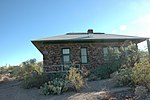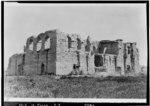Tumamoc Hill

Tumamoc Hill (O'odham: Cemamagĭ Doʼag) is a butte located immediately west of "A" Mountain and downtown Tucson, Arizona. It is home to many radio, television, and public safety transmitters. The 860-acre ecological reserve and U.S. National Historic Landmark was established by the Carnegie Institution in 1903. The University of Arizona (UA) owns a 340-acre (1.4 km2) preserve and leases another 509 acres (2.06 km2) as a research and education facility. The Steward Observatory maintains a small astronomical observatory with a 20-inch (510 mm) telescope on the hill. Besides being a prominent landmark, Tumamoc Hill has a long and varied history, and is currently an important site for ecological and anthropological research as well as a refuge and a recreational option for the people of Tucson. Part of the University of Arizona, the Desert Laboratory is located on Tumamoc.
Excerpt from the Wikipedia article Tumamoc Hill (License: CC BY-SA 3.0, Authors, Images).Tumamoc Hill
West Anklam Road, Tucson
Geographical coordinates (GPS) Address Nearby Places Show on map
Geographical coordinates (GPS)
| Latitude | Longitude |
|---|---|
| N 32.212777777778 ° | E -111.00611111111 ° |
Address
Tumamoc Desert Laboratory
West Anklam Road
85745 Tucson
Arizona, United States
Open on Google Maps







